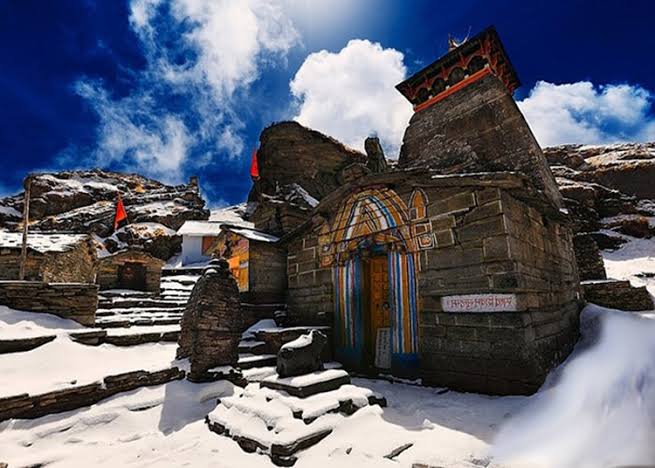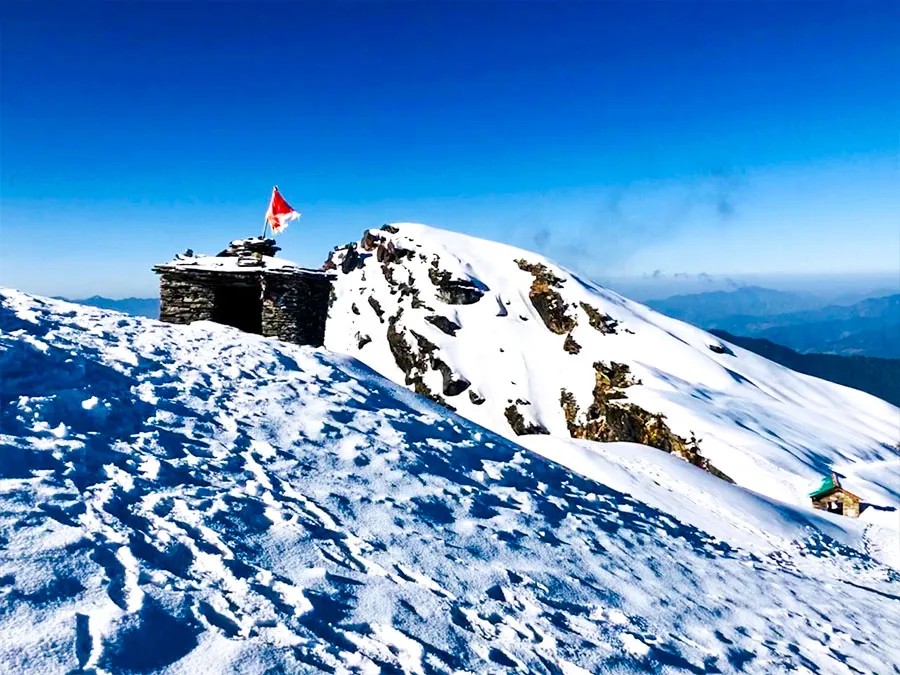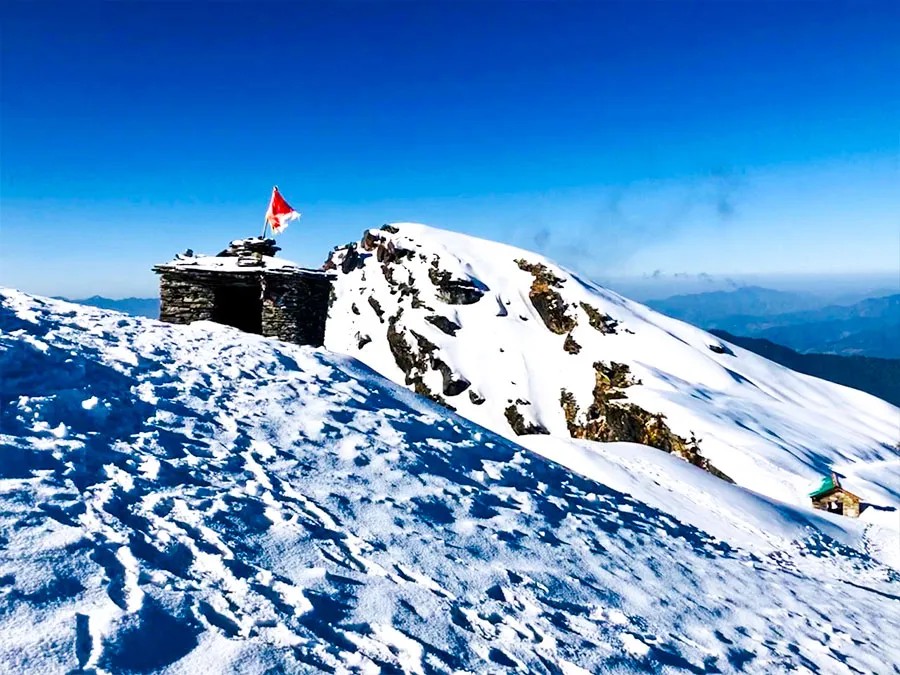The Chopta Tungnath trek takes you to the highest Shiva temple in the world and offers breathtaking views of the majestic Himalayan peaks. Located in the Rudraprayag district of Uttarakhand at an altitude of 3,680 meters (12,073 feet), this trek combines spiritual significance with natural beauty, making it a perfect blend of adventure and pilgrimage.
Overview
Chopta, often referred to as the 'Mini Switzerland of India', serves as the base for the trek to Tungnath and Chandrashila peak. The region is known for its lush meadows, dense forests, and panoramic views of snow-capped Himalayan peaks including Nanda Devi, Trishul, and Chaukhamba. The trek to Tungnath temple, the highest Shiva temple in the world, follows a well-defined path through rhododendron and oak forests. From Tungnath, a further climb leads to Chandrashila peak (4,000 meters), offering a 360-degree view of the Himalayan range. The combination of spiritual significance and natural beauty makes this trek a unique experience for both adventure enthusiasts and pilgrims.

Itinerary
Day 1: Drive from Rishikesh to Chopta (2,700 m) | 7-8 hours
The journey begins with a scenic drive from Rishikesh to Chopta, passing through Devprayag, Rudraprayag, and Ukhimath. Enjoy views of the Alaknanda and Mandakini rivers along the way. Upon arrival at Chopta, check into a guesthouse or camp and acclimatize to the altitude while enjoying the beautiful surroundings. Overnight stay in Chopta.
Day 2: Trek from Chopta to Tungnath (3,680 m) and Chandrashila (4,000 m) | 5.5 km | 5-6 hours
After breakfast, begin the trek to Tungnath temple through beautiful forests of rhododendron and oak. The well-marked trail gradually ascends for about 4 km (3-4 hours). After visiting the ancient Tungnath temple, continue the climb to Chandrashila peak (1.5 km, 1-2 hours) for panoramic views of the Himalayan range including Nanda Devi, Trishul, and Chaukhamba. Descend back to Chopta by evening. Overnight stay in Chopta.
Day 3: Drive from Chopta to Deoria Tal (2,438 m) and trek to the lake | 2 km | 1-2 hours
After breakfast, drive to Sari village (2-3 hours), the starting point for the Deoria Tal trek. From Sari, a 2 km trek through oak and rhododendron forests leads to the beautiful Deoria Tal lake, known for its reflections of Chaukhamba peaks. Spend time exploring the lake and surrounding areas. Return to Sari village and drive back to Chopta. Overnight stay in Chopta.
Day 4: Drive from Chopta to Rishikesh | 7-8 hours
After breakfast, begin the return journey to Rishikesh. The drive takes approximately 7-8 hours, passing through the same scenic route. Arrive in Rishikesh by evening, marking the end of the trek.

The Route
The trek begins from Chopta (2,700 meters), which is accessible by road from Rishikesh or Dehradun. From Chopta, a well-marked trail ascends through dense forests of rhododendron, oak, and pine trees. The 4 km trek to Tungnath temple takes approximately 3-4 hours at a moderate pace. After visiting the ancient temple, trekkers can continue for another 1.5 km to reach Chandrashila peak, which offers spectacular panoramic views of the Himalayan range. The return journey follows the same route back to Chopta. For those looking to extend their adventure, nearby attractions include Deoria Tal lake and the charming village of Rohini Bugyal.
Highlights Along the Way
- Visit to Tungnath, the highest Shiva temple in the world
- Panoramic views of major Himalayan peaks from Chandrashila summit
- Beautiful forests of rhododendron and oak trees (blooming with red flowers in spring)
- Lush green meadows of Chopta, known as the 'Mini Switzerland of India'
- Rich biodiversity with various Himalayan flora and fauna
- Blend of adventure and spiritual experience
Best Time to Visit
The Chopta Tungnath trek can be done throughout the year except during heavy monsoon (July-August) when trails become slippery. Spring (April-June) is ideal with moderate temperatures and blooming rhododendrons painting the forests in vibrant red. Autumn (September-November) offers clear skies and excellent visibility of distant Himalayan peaks. Winter (December-February) transforms the region into a snow-covered wonderland, though the temple remains closed during this period. The Tungnath temple officially opens in late April/early May (Akshaya Tritiya) and closes in November (Diwali).
Difficulty and Preparation
Chopta Tungnath is considered an easy to moderate trek suitable for beginners and families. The maximum altitude of 4,000 meters (Chandrashila peak) means some acclimatization is necessary, but altitude sickness is generally not a major concern for most trekkers. Basic physical fitness is sufficient, with the ability to walk 5-6 kilometers daily on inclined terrain. The trail is well-marked and maintained, making it accessible for first-time trekkers. For winter treks (December-February), additional preparation for cold weather and proper gear for walking on snow is necessary.

Accommodation
Accommodation options during the Chopta Tungnath trek include guesthouses, camps, and dharamshalas (pilgrim rest houses). In Chopta, several guesthouses and camps offer basic to comfortable accommodation with beautiful views of the surrounding mountains. Near Tungnath temple, simple dharamshalas provide shelter for pilgrims and trekkers, though facilities are basic. During peak season, it's advisable to book accommodation in advance. For those seeking a more immersive experience, camping in designated areas around Chopta is also an option, with several tour operators providing tented accommodation with necessary amenities.
Local Culture
The Chopta Tungnath region holds significant cultural and religious importance in Hindu mythology. According to legend, Tungnath is one of the Panch Kedar (five Shiva temples in the Garhwal region), believed to be established by the Pandavas to seek Lord Shiva's forgiveness after the Mahabharata war. The temple architecture reflects the traditional Garhwali style, with intricate stone carvings and a conical roof. The local communities, primarily of Garhwali origin, maintain their traditional lifestyle, customs, and festivals. During the temple's opening ceremony in April/May, the region comes alive with religious ceremonies and cultural celebrations.
Conservation
The Chopta Tungnath region falls within the buffer zone of the Kedarnath Wildlife Sanctuary, home to diverse Himalayan flora and fauna including musk deer, Himalayan black bear, and numerous bird species. Conservation efforts focus on preserving this fragile ecosystem while promoting sustainable tourism. Trekkers are expected to follow responsible practices such as carrying back all non-biodegradable waste, staying on marked trails, and not disturbing the local wildlife. The increasing popularity of the trek has raised concerns about environmental impact, leading to various initiatives by local communities and forest departments to maintain the ecological balance of this beautiful region.
Frequently Asked Questions
Is Chopta Tungnath suitable for beginners?
Yes, Chopta Tungnath is an ideal trek for beginners due to its well-marked trails, moderate altitude gain, and relatively short distance. The trek can be completed by anyone with basic fitness levels and doesn't require any technical climbing skills.
When is the Tungnath temple open for visitors?
The Tungnath temple officially opens in late April or early May (on Akshaya Tritiya) and closes in November (around Diwali). During winter months, the temple remains closed due to heavy snowfall, though trekkers can still visit the area.
Can I see snow during the Chopta Tungnath trek?
Yes, if you visit during winter months (December to March), you'll find the entire region covered in snow, offering a magical winter wonderland experience. However, trekking during this time requires proper gear and preparation for cold conditions.
What makes Chandrashila peak special?
Chandrashila peak, at 4,000 meters, offers one of the most spectacular 360-degree panoramic views of the Himalayan range. On a clear day, you can see major peaks including Nanda Devi, Trishul, Kedar Peak, Bandarpunch, and Chaukhamba. According to legend, Lord Rama meditated on this peak after defeating Ravana.
Is there network connectivity during the trek?
Network connectivity is limited during the trek. You might get patchy signals in Chopta, but as you ascend towards Tungnath and Chandrashila, expect to be disconnected. It's advisable to inform family and friends about your limited connectivity beforehand.
Trek Information
Location
Uttarakhand, India
Duration
3-4 days
Difficulty
Easy to Moderate
Best Season
April-June, September-November
Group Size
8-15 people
Max Altitude
4,000 m (Chandrashila Peak)
Start & End Point
Chopta
Inclusions & Exclusions
✅ Included:
- ✔Transportation from Rishikesh to Chopta and back
- ✔Accommodation in guesthouses/camps in Chopta
- ✔All meals during the stay in Chopta
- ✔Qualified and experienced trek leader and support staff
- ✔First aid medical kit
- ✔Permits and entry fees
❌ Excluded:
- ✖Personal expenses and tips
- ✖Travel insurance
- ✖Any costs arising out of unforeseen circumstances like landslides, roadblocks, bad weather
- ✖Anything not mentioned in inclusions
What to Pack
- Good quality trekking shoes with ankle support
- Layered clothing (thermal inner wear, fleece jacket, windproof outer layer)
- Rain protection (poncho or waterproof jacket)
- Sun protection (hat, sunglasses, sunscreen)
- Trekking poles for stability on steep sections
- Headlamp with extra batteries
- Personal medical kit with basic medications
- Water bottles and water purification tablets
- Warm gloves, socks, and cap (especially for early morning Chandrashila climb)
- Camera with extra batteries (for capturing the stunning landscapes)
Weather Conditions
Spring (April-June)
Daytime temperatures 15-20°C, night temperatures 5-10°C, occasional light showers
Summer (June-August)
Daytime temperatures 12-18°C, night temperatures 5-8°C, possibility of monsoon rains
Autumn (September-November)
Daytime temperatures 10-15°C, night temperatures 0-5°C, clear skies and stable weather
Winter (December-February)
Daytime temperatures 0-5°C, night temperatures -10 to -5°C, heavy snowfall
Food & Cuisine
Food options during the Chopta Tungnath trek range from simple to delicious local cuisine. In Chopta, several small restaurants and guesthouses serve vegetarian meals including North Indian, Garhwali, and basic continental dishes. Near Tungnath temple, small shops offer tea, maggi noodles, and basic snacks. During the trek, it's advisable to carry some energy bars, dry fruits, and water. The local Garhwali cuisine, known for its simplicity and nutritional value, includes dishes prepared with locally grown grains, lentils, and vegetables, providing the necessary energy for trekking.
Local Specialties:
- Mandua ki Roti - Nutritious flatbread made from finger millet
- Jhangora ki Kheer - Sweet pudding made from barnyard millet
- Aloo ke Gutke - Spicy potato dish with local herbs
- Kafuli - Spinach and fenugreek leaves preparation
- Garhwali Dal - Local lentil preparation with unique spices
